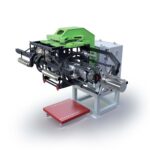The Aston Martin Vantage GT8 is powered by the company’s 4.7L V8 engine, which has been fettled with to produce 328kW (440hp) of power, while torque remains unchanged at 490Nm (361lb-ft). As before, all of that power is sent to the rear wheels via a limited-slip diff, through either a 6-speed manual or 7-speed automatic transmission. To help make the small power increase go a little further, Aston have managed to shave around 100 kilograms off the weight of the car, thanks to carbon fibre front seats, a lithium-ion battery, and carbon fibre door panels.
Visually, we think the Vantage GT8 is a bit of a mixed bag. Aston say it was inspired by the V8 Vantage GTE race car, and it features carbon fibre exterior body work with pumped up guards, including cutaways behind the front wheels. Other exterior goodies include the carbon fibre front splitter, side sills, rear diffuser, and both the front and rear bumpers. An optional aero package (as shown) adds corner elements to the front splitter and a large rear wing.
Other optional items include polycarbonate rear windows, a carbon fibre roof and boot, titanium exhaust, and a three ‘hero’ paint packages (grey and blue; white; or green and lime). With all the lightweight options fitted, the GT8 tips the scales at 1510 kilograms. Aston Martin expects that the GT8 will be able to complete the 0-60mph (0-97km/h) dash in 4.4 seconds and have a top speed of 306km/h. In comparison, the regular V8 Vantage GT requires 4.6 seconds to do that.
Production of the GT8 will be limited to just 150 units, and will be sold in all major markets except North America.














